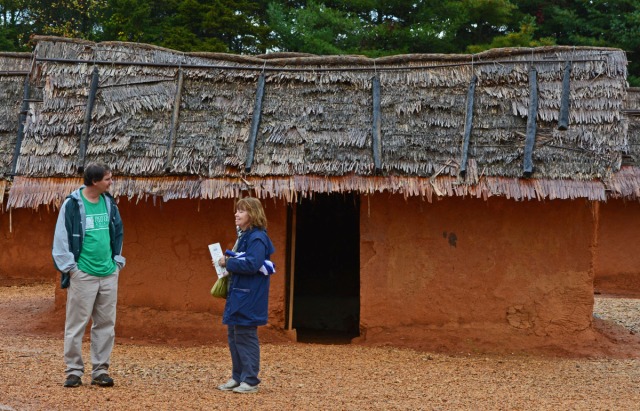The 1700s saw a peak period in the transatlantic slave trade. Between 1716 and 1755, 30,000 Igbos were brought to Colonial Virginia as enslaved farm laborers, domestic servants, and artisans. Igboland is now part of modern-day Nigeria.
The Frontier Culture Museum, which I introduced a few days ago with the 17th century English farmhouse, also houses an Igbo compound to honor the contributions made by Africans to the developing American culture. This compound is a re-creation of a prosperous Igbo household in the 1700s.
The orange tones here reminded me very much of the reddish soil I had seen during my visit to West Africa many years ago.
Stepping through the gate, I felt transported back to the continent that was Mother to all of us so long ago:
It had been raining most of the day and the rivulets of water transformed the court yard into a soggy, muddy quagmire:
This Australian visitor was undeterred by the rain (Hello, Lolla!) and asked the museum staff person many questions:
We learned that the Igbo were an industrious and flourishing tribe in the Biafran hinterlands. They had domesticated many plants and animals. Their farming techniques were well adapted to the surrounding rainforest environment. Land was cleared with machetes and fire for food production.
The men grew the all important yam, a starchy tuber, while the women raised vegetables and other tubers in between the yam hills. An average household (consisting of a male with several wives, their children, and often additional relatives) required a large amount of yam. Many hundreds of hills of seed yams had to be planted and carefully tended to in order to secure an abundant harvest.
Each stage of the yam’s growth was marked with rituals and celebrations, ending with the harvest and storage of the tubers in a barn. The importance of yam to Igbo culture reminded me very much of the significance of corn to many Native American tribes.
The Igbo were well known for their basket weaving and pottery making skills. These are samples of essential food and water storage containers found in a typical household.
The buildings and compound enclosure were constructed with clay, bamboo, and local wood. Roofs were made from raffia palm thatch.
The Igbo practiced the art of weaving to produce essential textile products for the household.
The inside of a house contained various household and ritual objects.
Leaving the compound felt like a fast-forward motion into a different time and place, especially when the world beyond the compound walls re-appeared.
The theme of the Weekly Photo challenge is: Orange.

























I never knew about the Igbos, Annette, so thanks for teaching me something new. It’s interesting how their food production was centered on the yam. This is a perfect post for orange! 🙂
LikeLike
I believe that the Sea Islanders in South Carolina and Georgia (the Gullah people) are descendants of the Nigerian Igbos. They have preserved many of their customs (foods, music, even language) to this day. And, of course, they are known for their amazing basket weaving skills.
LikeLiked by 1 person
What an experience to have looking over the compound, rich in history! Beautiful photography, thank you for sharing 🙂
LikeLike
Entering a different world without the cost of travel 🙂
LikeLike
Thanks for sharing your experience of a simpler way of life.
LikeLike
You are welcome, Aggie.
LikeLike
Interesting! Thanks for taking time to share this with us.
Nancy
LikeLike
Thanks for reading and commenting, Nancy.
LikeLiked by 1 person
Super post! I learned something new, and your photos took me there. Great pick for the theme “orange”. —- Jane
LikeLike
Thank you, Lola Jane, glad you enjoyed the post.
LikeLike
Always being taught something new from you. Have you been in Santa Fe, I am planning a camping trip this summer. If so any recommendations? I have been there about 30 years ago. Thank you Annette. Cornelia
LikeLike
That’s almost as long as the last time I was in Santa Fe. Apart from all the museums, restaurants, and Native artwork, I’d recommend the Bandelier area (don’t remember how much of a drive it was) – beautiful remnants of cliff dwellings, kivas, and just stunning scenery…
LikeLiked by 1 person
Thank you Annette.
LikeLike
Never heard of Igbos, this was a very interesting read. Correct me if I’m wrong, but I’ve heard a few times that yam was very popular there in Nigeria, sort of like a food staple. They take quite a while to harvest, and they really aren’t cheap to buy either. Beautiful orange photos. Very earthy and it reminds me that we all need to get down and dirty when we want to harvest natural crops for food 🙂
LikeLike
The Igbos are still a significant tribal group in Nigeria. I have seen some of their stunning sculptures.
Yes, yam is an important staple in many tropical places because it is a very starchy tuber that provides a lot of calories. There are lots of tubers in many other places in the world that fulfill a similar function (think potatoes, sweet potatoes, taro, tanya, cassava). I love to grow different kinds of potatoes (purple, gold, white) and sweet potatoes (they have barely enough growing season where I live but some yrs they do really well). Tubers make great comfort foods!
LikeLike
Yes, tubers are really good comfort foods. A bit of it makes me full, so I tend to have small servings of it. Yam is a very popular food in Malaysia too, both steamed and fried, and commonly eaten at family gathering dinners.
LikeLike
Wow, an excellent informative post. How interesting that so many of one tribe remained intact in this part of VA instead of being scattered all over the south. Have you tried growing gourds, Annette?
LikeLike
Hi Barbara – yes, I’ve grown birdhouse gourds and now they are sitting around in the shed waiting for someone to give them an artsy rebirth 🙂 Want any?
LikeLiked by 1 person
Yes! !! I would love some. Thank you, Annette 😊
LikeLike
Cool, next time we meet….remind me, please.
LikeLiked by 1 person
Will do and thanks😊
LikeLike